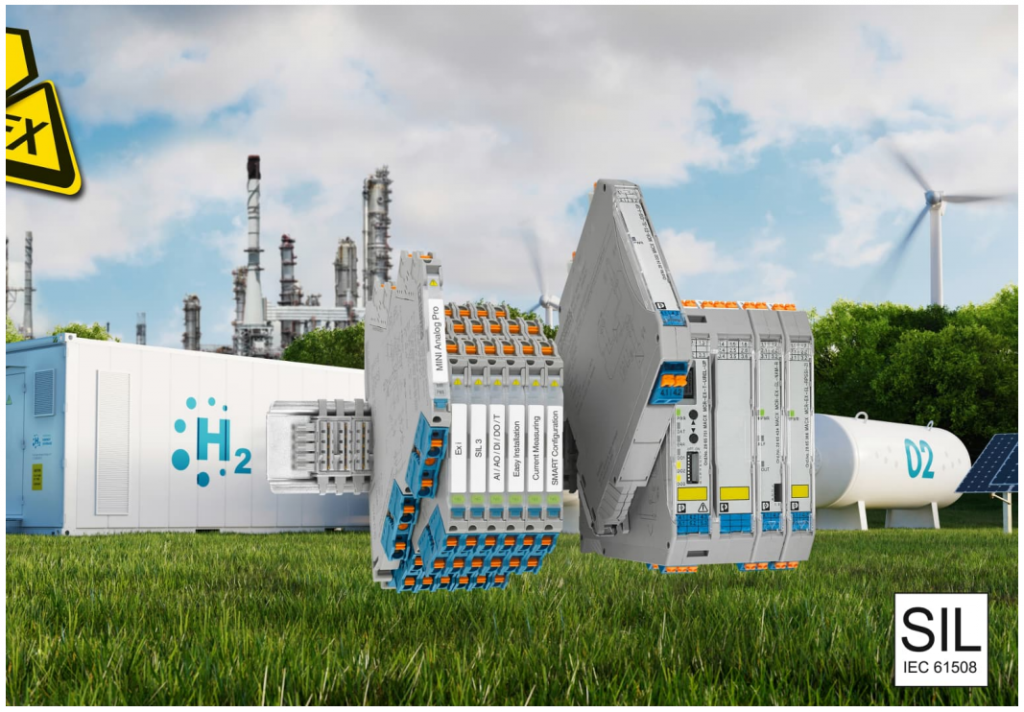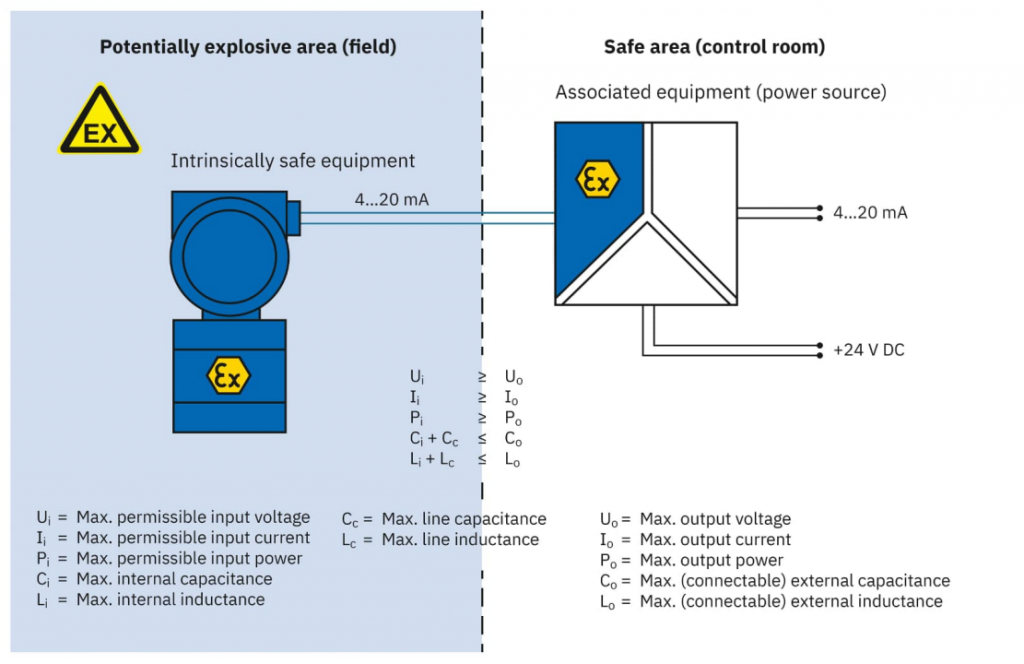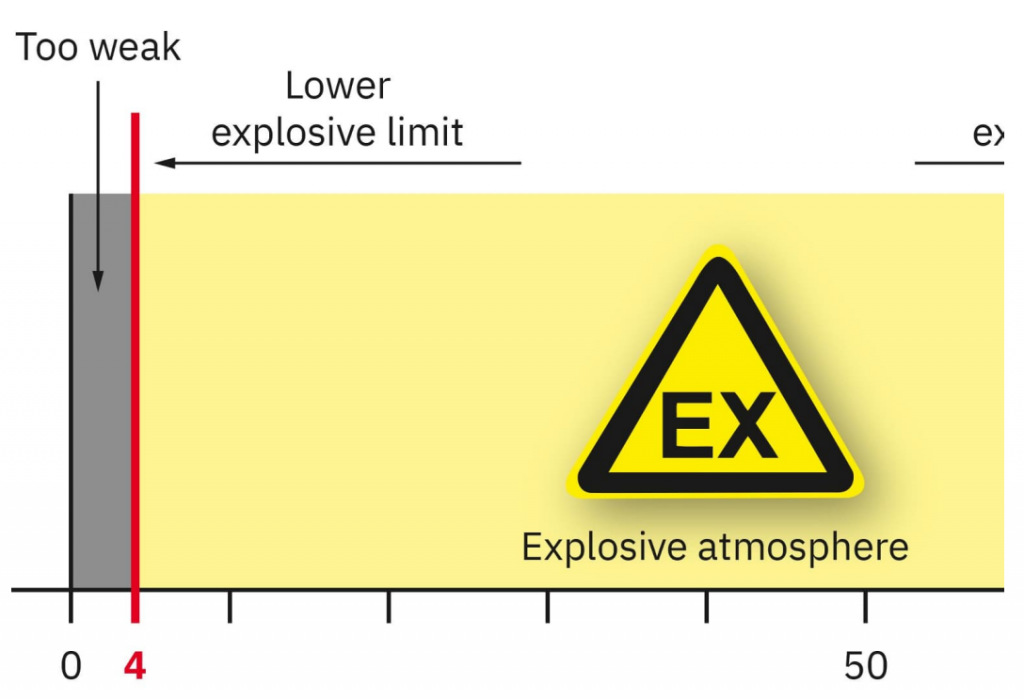Compact Ex i isolators for quick and error-free connection in various applications
Green hydrogen (H₂) is emerging as a crucial alternative to fossil fuels like oil, gas, and coal. Chemical plants, refineries, copper smelters, steelworks, and the mobility sector, aim to use it to achieve climate neutrality. Ex i isolators are employed to safeguard systems from explosions.

In 2023, the German government decided to significantly enhance the role of hydrogen in its updated national strategy by 2030. They aim to have 95 to 130 TWh of hydrogen available by then, with demand projected to reach 500 to 600 TWh by 2045. For comparison, Germany consumed around 866 TWh of natural gas in 2022. To meet these targets, the entire hydrogen value chain must be rapidly expanded. From production by electrolyzers from renewable energy to storage, processing, and distribution.
Challenges in the use of hydrogen
Hydrogen’s high energy content and carbon-neutral combustion, producing only water (H₂O), are significant advantages. However, handling H₂ requires caution due to its properties. It is fourteen times lighter than air, leading to rapid evaporation in open-air systems. It also has high diffusivity, allowing it to penetrate other media. Hydrogen is also highly explosive, with a minimum ignition energy of 0.02 mJ, one of the lowest among flammable gases. It belongs to the most dangerous ignition group IIC, along with acetylene and carbon disulfide. It also has a wide explosive range from 4% to 77% by volume in air.

Ex i type of protection for secondary explosion protection
Manufacturers and operators of hydrogen plants, like electrolyzers and transfer points, must conduct a risk analysis to identify potential explosion hazards and their likelihood (zoning per EN/IEC 60079-10). They must implement primary explosion protection measures to prevent explosive atmospheres, or secondary measures to prevent ignition sources, following the EN/IEC 60079 standards.
Intrinsic safety (Ex i) protection is widely used in measurement and control technology for potentially explosive areas. It offers a cost-effective design compared to flameproof enclosures (Ex d) and allows maintenance and alterations during operation. According to EN/IEC 60079-11, Ex i protection limits the energy conducted to and stored in potentially explosive areas. This ensures that any potential spark energy remain below the minimum ignition energy, preventing incendive surfaces.
Limiting the energy conducted into the Ex area
Intrinsically safe circuits typically consist of three elements:
- The intrinsically safe equipment, i.e., a load installed in the Ex area (such as an Ex i temperature transmitter)
- The associated equipment, i.e., a source installed in the non-Ex area (Ex i isolator)
- The connecting line (cable)
Ex i isolators are crucial for electrically isolating intrinsically safe circuits from non-intrinsically safe ones, as per EN/IEC 60079-0 and -11. They limit the energy (maximum no-load voltage Uo, short-circuit current Io, and power Po) to non-incendive levels. Additionally, they determine the maximum allowable energy storage elements. These element include Capacitance Ci and inductance Li in the field device, line capacitances Cc, and line inductances Lc. They can be connected without compromising intrinsic safety of the circuit.
To prevent incendive sparks or hot surfaces, users or system operators must provide and document “proof of intrinsic safety”. It has to be in accordance with EN/IEC 60079-11 and construction standard EN/IEC 60079-14. This allows users to select and combine Ex i field devices and Ex i isolators from various manufacturers to meet specific requirements.

Compliance with functional safety standards
Primary explosion protection aims to prevent explosive atmospheres such as the formation of flammable gases. Or altering the gas/air mixture concentration through measures like technical ventilation. For process reliability in systems used in green hydrogen production and distribution, compliance with IEC 61508 and IEC 61511 on functional safety is required. For example, for measuring and control circuits with pressure, temperature, and gas detection sensors, flow meters, and actuators.
Customized Ex i interface solutions
Phoenix Contact’s Ex i signal conditioners and measuring transducers offer customized solutions for various applications. They support both small, decentralized signal quantities (like H2 service stations) and large system solutions (such as 20 MW PEM electrolysis plants), with plug-and-play connections for standard and universal I/O cards.
MINI Analog Pro
The new, highly compact Ex i signal conditioners and measuring transducers in the Mini Analog Pro series, offer key functions like analog and digital input/output, and temperature measurement. Awarded the German Innovation Award in 2023, these devices combine intrinsic safety and functional safety up to SIL 3 in a 6.2 mm width. They operate from -40°C to 70°C, saving space and providing user-friendly design, extensive parameterization options, end-to-end digitalization, and optional plug-in communication gateways.
MACX Analog
The MACX Analog series Ex i signal conditioners and measuring transducers, widely used and continuously improved, offer a range of functions in a 12.5 mm width. This includes single- and two-channel solutions, signal duplicators, limit value switches, special functions, and performance level certification per EN ISO 13849.
Both Mini and MACX devices feature accessible, plug-in terminal blocks and a shared power bridging system via modular DIN rail connectors, allowing combined installation. They support quick, error-free plug-and-play connections to standard I/O cards from various control system manufacturers using universal or system-specific Termination Carriers.

VIP I/O
VIP I/O marshalling provides an interface system for universal I/O cards, featuring a 16-channel base module, plug-in function modules, and system cables. It combines signal marshalling and processing, with field signals routed directly to the base elements. Users can adapt functions by plugging in function modules, saving space on marshalling and interface cabinets, eliminating cross-wiring, and reducing project processing times.

Use in all Ex zones and for all substance groups
Phoenix Contact’s Ex i signal conditioners are designed for use in various explosive zones, complying with ATEX approvals and suitable for both gas and dust environments, including the highest-risk zones 0 and 20. They offer flexibility and compatibility with numerous Ex i field devices due to their optimized Io, Uo, and Po values. Installing the MACX series in Ex zone 2 under Ex n and Ex ec protection types, can facilitate decentralized automation. International approvals like IECEx, UL, CCC, and INMETRO, are prerequisites for their use in applications across the globe. Additionally, all Ex i isolators are certified for safety functions up to SIL 2 or SIL 3 as per IEC EN 61508.
For further information, please visit our website.

